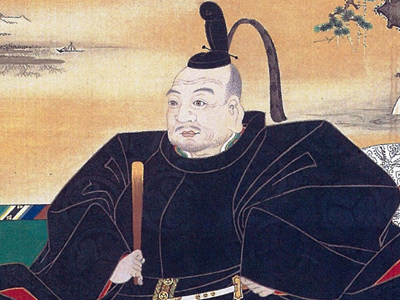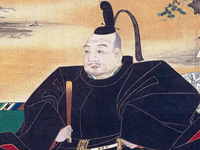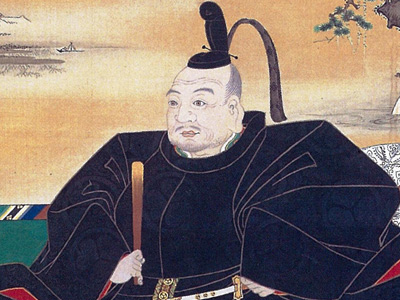Tokugawa Ieyasu (1543-1616)

Ogosho (1605–1616)
Ieyasu, acting as the retired shogun (大御所 ōgosho), remained the effective ruler of Japan until his death. Ieyasu retired to Sunpu Castle in Sunpu, but he also supervised the building of Edo Castle, a massive construction project which lasted for the rest of Ieyasu's life. The result was the largest castle in all of Japan, the costs for building the castle being borne by all the other daimyōs, while Ieyasu reaped all the benefits. The central donjon, or tenshu, burned in the 1657 Meireki fire. Today, the Imperial Palace stands on the site of the castle.
In 1611, Ieyasu, at the head of 50,000 men, visited Kyoto to witness the enthronement of Emperor Go-Mizunoo. In Kyoto, Ieyasu ordered the remodeling of the imperial court and buildings, and forced the remaining western daimyōs to sign an oath of fealty to him.
In 1613, he composed the Kuge Shohatto (ja:公家諸法度), a document which put the court daimyōs under strict supervision, leaving them as mere ceremonial figureheads.
In 1615, Ieyasu prepared the Buke shohatto (武家諸法度), a document setting out the future of the Tokugawa regime.
Relations with Foreign Powers
As Ogosho, Ieyasu also supervised diplomatic affairs with the Netherlands, Spain The Spanish Empire was a colonial empire governed by Spain and its predecessor states between 1492 and 1976. One of the largest empires in history, it was the first to usher the European Age of Discovery and achieve a global scale, controlling vast territory. It was one of the most powerful empires of the early modern period, reaching its maximum extent in the 18th century. and the England
The Spanish Empire was a colonial empire governed by Spain and its predecessor states between 1492 and 1976. One of the largest empires in history, it was the first to usher the European Age of Discovery and achieve a global scale, controlling vast territory. It was one of the most powerful empires of the early modern period, reaching its maximum extent in the 18th century. and the England The Kingdom of England was a sovereign state on the island of Great Britain from about 927, when it emerged from various Anglo-Saxon kingdoms, until 1 May 1707, when it united with Scotland to form the Kingdom of Great Britain. The Viking invasions of the 9th century upset the balance of power between the English kingdoms, and native Anglo-Saxon life in general. The English lands were unified in the 10th century in a reconquest completed by King Æthelstan in 927.. Ieyasu chose to distance Japan from European influence starting in 1609, although the shogunate did still grant preferential trading rights to the Dutch East India Company and permitted them to maintain a "factory" for trading purposes.
The Kingdom of England was a sovereign state on the island of Great Britain from about 927, when it emerged from various Anglo-Saxon kingdoms, until 1 May 1707, when it united with Scotland to form the Kingdom of Great Britain. The Viking invasions of the 9th century upset the balance of power between the English kingdoms, and native Anglo-Saxon life in general. The English lands were unified in the 10th century in a reconquest completed by King Æthelstan in 927.. Ieyasu chose to distance Japan from European influence starting in 1609, although the shogunate did still grant preferential trading rights to the Dutch East India Company and permitted them to maintain a "factory" for trading purposes.
From 1605 until his death, Ieyasu consulted frequently with English shipwright and pilot, William Adams, Adams, fluent in Japanese, assisted the shogunate in negotiating trading relations, but was cited by members of the competing Jesuit and Spanish-sponsored mendicant orders as an obstacle to improved relations between Ieyasu and the Roman Catholic Church.
Significant attempts to curtail the influence of Christian missionaries in Japan date to 1587 during the shogunate of Toyotomi Hideyoshi. However, in 1614, Ieyasu was sufficiently concerned about Spanish territorial ambitions that he signed a Christian Expulsion Edict. The edict banned the practice of Christianity and led to the expulsion of all foreign missionaries. Although some smaller Dutch The Dutch Republic was a confederation that existed from 1579, during the Dutch Revolt, to 1795. It was a predecessor state of the Netherlands and the first fully independent Dutch nation state. Although the state was small and contained only around 1.5 million inhabitants, it controlled a worldwide network of seafaring trade routes. The income from this trade allowed the Dutch Republic to compete militarily against much larger countries. It amassed a huge fleet of 2,000 ships, initially larger than the fleets of England and France combined. trading operations remained in Nagasaki, this edict dramatically curtailed foreign trade and marked the end of open Christian witness in Japan
The Dutch Republic was a confederation that existed from 1579, during the Dutch Revolt, to 1795. It was a predecessor state of the Netherlands and the first fully independent Dutch nation state. Although the state was small and contained only around 1.5 million inhabitants, it controlled a worldwide network of seafaring trade routes. The income from this trade allowed the Dutch Republic to compete militarily against much larger countries. It amassed a huge fleet of 2,000 ships, initially larger than the fleets of England and France combined. trading operations remained in Nagasaki, this edict dramatically curtailed foreign trade and marked the end of open Christian witness in Japan Japan is an island country in East Asia. Beginning in the 12th century, political power was held by a series of military dictators (shōgun) and feudal lords (daimyō) and enforced by a class of warrior nobility (samurai). In the Meiji period, the empire adopted a Western-modeled constitution and pursued a program of industrialization and modernization. A global leader in the automotive, robotics and electronics industries, Japan has made significant contributions to science and technology. until the 1870s. The immediate cause of the prohibition was the Okamoto Daihachi incident, a case of fraud involving Ieyasu's Catholic vavasor, but the shogunate was also concerned about a possible invasion by the Iberian colonial powers, which had previously occurred in the New World and the Philippines.
Japan is an island country in East Asia. Beginning in the 12th century, political power was held by a series of military dictators (shōgun) and feudal lords (daimyō) and enforced by a class of warrior nobility (samurai). In the Meiji period, the empire adopted a Western-modeled constitution and pursued a program of industrialization and modernization. A global leader in the automotive, robotics and electronics industries, Japan has made significant contributions to science and technology. until the 1870s. The immediate cause of the prohibition was the Okamoto Daihachi incident, a case of fraud involving Ieyasu's Catholic vavasor, but the shogunate was also concerned about a possible invasion by the Iberian colonial powers, which had previously occurred in the New World and the Philippines.
Siege of Osaka
The last remaining threat to Ieyasu's rule was Toyotomi Hideyori, the son and rightful heir to Hideyoshi. He was now a young daimyō living in Osaka Castle. Many samurais who opposed Ieyasu rallied around Hideyori, claiming that he was the rightful ruler of Japan. Ieyasu found fault with the opening ceremony of a temple built by Hideyori; it was as if he prayed for Ieyasu's death and the ruin of the Tokugawa clan. Ieyasu ordered Toyotomi to leave Osaka Castle, but those in the castle refused and summoned samurai to gather within the castle. Then the Tokugawa, with a huge army led by Ieyasu and Shogun Hidetada, laid siege to Osaka castle in what is now known as "the Winter Siege of Osaka". Eventually, Tokugawa was able to precipitate negotiations and an armistice after directed cannon fire threatened Hideyori's mother, Yodo-dono. However, once the treaty was agreed, Tokugawa filled the castle's outer moats with sand so his troops could walk across. Through this ploy, Tokugawa gained a huge tract of land through negotiation and deception that he could not through siege and combat. Ieyasu returned to Sunpu Castle once, but after Toyotomi refused another order to leave Osaka, he and his allied army of 155,000 soldiers attacked Osaka Castle again in "the Summer Siege of Osaka".
Finally, in late 1615, Osaka Castle fell and nearly all the defenders were killed including Hideyori, his mother (Hideyoshi's widow, Yodo-dono), and his infant son. His wife, Senhime (a granddaughter of Ieyasu), pleaded to save Hideyori and Yodo-dono's lives. Ieyasu refused and killed both of them. Eventually, Senhime was sent back to Tokugawa alive. After killing two people at Kamakura(鎌倉), who have escaped from Osaka-jo (大阪城).With the Toyotomi line finally extinguished, no threats remained to the Tokugawa clan's domination of Japan.
HISTORY

RESOURCES
This article uses material from the Wikipedia article "Tokugawa Ieyasu (1543-1616)", which is released under the Creative Commons Attribution-Share-Alike License 3.0.
© Stories Preschool. All Rights Reserved.









